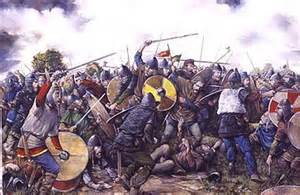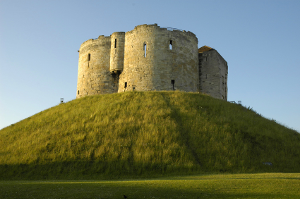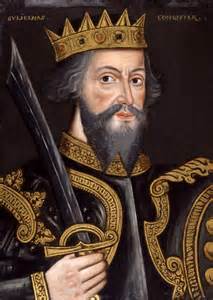William the Conqueror
William, Duke of Normandy, better known in English circles as William the Conqueror, was born in 1028, the son of a Norman duke, but his mother wasn't the duke's wife. William's father, Richard, was the brother of Emma, who was queen in England when both Æthelred II and Denmark's Canute were on the English throne. When Richard died in 1035, William's family proclaimed William the heir to the Norman holdings. William proved astute militarily from an early age. A powerful presence on the battlefield and at court, William paid a state visit to England in 1051. William later claimed that during this visit, the English king at the time, Edward the Confessor, promised William the English throne. (The two knew each other from a previous interaction, when William served as guardian to Edward and his brother Alfred when the two youngsters were living in Normandy to avoid Canute's Danish invasion of England.) William further claimed that in 1064, Harold Godwinson, a powerful Saxon noble, supported William's claim to the kingship. Harold was with King Edward when the king died, on January 5, 1066, and Harold reported that Edward had granted the kingship to him, Harold. Hearing of this, William felt aggrieved and set about efforts to take the kingship by force.
Harold, who had made his reputation as a man of action, especially in his lightning-fast march up to Yorkshire, decided not to wait for William to march his troops to London. It wasn't the four days that the northern journey was, but the movement south was done in relatively quick fashion, including a week or so to solidify the north in the wake of Tostig's uprising. This time, however, some of the northern barons and their military compatriots decided to sit out the fighting. Harold gathered weapons and steam as he marched his troops southward, and they arrived in early October in the vicinity, where William and his troops had decided to wait. Harold chose the high ground to make his stand, especially because William had brought a host of archers and cavalry that the Saxon army didn't have. Still, the vaunted Saxon Wall, a series of interlocked shields that protected the soldiers who stood in tight formation, proved more than enough for the volleys of arrows that flew uphill on October 14, 1066. Once the Norman arrow supply was exhausted, with little apparent effect on the Saxon defenders atop the hill, William ordered a cavalry charge. The combination of the heavy horse carrying armored knights and a sharp gallop uphill meant that the Saxon defenders, stationary though they were, could negate the normal advantage of charging cavalry. The Saxon Wall held again, not the least because the defenders were wielding heavy axes that could cut down both horse and rider. Somewhere along the way, though, William disappeared from view, for long enough that his men thought he was dead. News of his "death" spread throughout the battlefield, and the attack faltered, with dozens of Normans reeling in retreat in fear of losing their will in addition to their leader. Harold's Saxons, who were under strict orders not to give up their high ground, couldn't help themselves and charged after the retreating Normans. 
William reappeared, removed his helmet so his troops could see that he was indeed alive, and the result was a renewed attack. Caught rushing downhill or, in some cases, on the flat, the less mobile Saxons found themselves outnumbered and outflanked and, then, cut to pieces. Harold urged his troops to hold their lines, but a few more Norman "attack-retreat-attack" iterations resulted in many more Saxon deaths. The Normans, mindful of the Saxon Wall and the heavy axes, were cautious in a renewed attack. But another attack came, and another one followed that. Eventually, the Norman charge succeeded, overwhelming the Saxon defenses and resulting in the death of Harold himself, who some sources say was gravely wounded by an arrow to the eye and then the victim of a fierce Norman charge toward the end of the day. Their leader gone, the Saxon force dissolved into full-blown retreat, and the result was the Normans' claiming the hill and victory. William was disappointed when expecting English nobles to prostrate themselves before him straight after the Battle of Hastings. Tired of waiting, William marched himself and his troops to London, where he assumed control. He was crowned king on Christmas Day 1066 in Westminster Abbey. 
Despite all of his efforts to take the throne, however, William found that he missed Normandy enough to go home, leaving his half-brother and another trusted official behind as co-regents. Harold's sons didn't go quietly, leading raids throughout the southern part of England. William had to expend energy and even make some personal appearances to put down this disquiet. It took William himself to put down another Danish invasion, this one, in 1069, resulting in the brief Danish seizure of York. William stuck around more after that, laying waste to Danish and Saxon resistance across Mercia and Northumbria. William increased his influence into Scotland, resulting in the Treaty of Abernethy in 1072. In response to all of this unrest, William mandated a program of castle-building that continued long enough to have produced 80 castles throughout the kingdom. As king, William seized large amounts of land from Saxon nobles and their heirs (including the descendants of many who died at Hastings). This resulted in a significant increase in the revenues streaming into the king's coffers. Throughout the countryside, however, despite all of William's military efforts, confusion still reigned as to population and economy. Sensing an opportunity to maximize tax revenues, William ordered a realm-wide survey of the people and their property. The result of this was Domesday Book, which was finalized in 1086. The following year, William returned to Normandy to defend those lands against attacks from elsewhere in France. He died in the process, on September 9, 1087. He left Normandy to his oldest son, Robert. His third son became England's King William II, and his fourth son became England's King Henry I. William's legacy, however, was the Norman Conquest. |
|
Social Studies for Kids
copyright 2002–2026
David White



 William had been making noises about invading England all year, and Harold had bulked up the defenses in the south, awaiting an invasion. But William took his time, for a variety of reasons, including weather and supply chains, finally putting ashore in late September.
William had been making noises about invading England all year, and Harold had bulked up the defenses in the south, awaiting an invasion. But William took his time, for a variety of reasons, including weather and supply chains, finally putting ashore in late September. 
